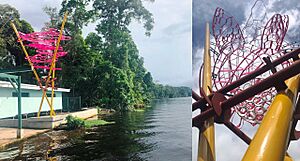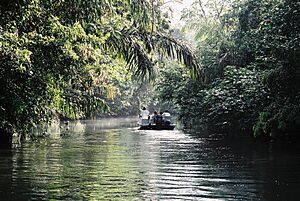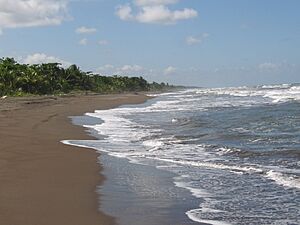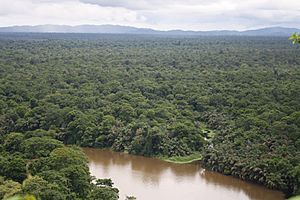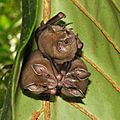Tortuguero National Park facts for kids
Quick facts for kids Tortuguero National Park |
|
|---|---|
|
IUCN Category II (National Park)
|
|
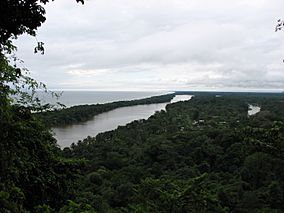
View from Tortuguero Mountain
|
|
| Location | Costa Rica |
| Nearest city | Tortuguero |
| Area | 312 km2 (194 m2) |
| Established | 1975 |
| Visitors | 10,000 (in 1995) |
| Governing body | National System of Conservation Areas (SINAC) |
| Lua error in Module:Location_map at line 420: attempt to index field 'wikibase' (a nil value). | |
| Official name: Humedal Caribe Noreste | |
| Designated: | 20 March 1996 |
| Reference #: | 811 |
Tortuguero National Park is a special national park located in the Limón Province of Costa Rica. It's found in the northeastern part of the country, within the Tortuguero Conservation Area.
Even though you can only get there by airplane or boat, it's one of the most visited parks in Costa Rica! The park is home to a huge variety of plants and animals. This is because it has many different types of nature, like rainforests, mangrove forests, swamps, beaches, and lagoons. It's in a tropical climate, which means it's very humid and gets a lot of rain every year.
This park is a protected area within the wetlands of the Caribbean coast. It was recognized internationally in 1991 by the Ramsar Convention. This was because of its rich variety of living things and its important ecosystems. These ecosystems help support many plant and animal species that are in danger. The park also connects with another protected area, the Indio Maíz Biological Reserve in Nicaragua. It's a key site for wetland protection.
Contents
Exploring Tortuguero National Park
Tortuguero National Park is located on the Caribbean coast of Costa Rica. It covers a very large area, about 77,032 acres. The park has over 20 miles of coastline, which is a super important place for sea turtles to lay their eggs safely.
The park is bordered by other natural areas. To the north is the Barra del Colorado Wildlife Refuge, which has similar nature. To the south, you'll find the mouth of the Parismina River and the Cariari National Wetlands. The town of Tortuguero is also nearby. There's even a special place called the Dr. Archie Carr Wildlife Refuge, which helps study and protect turtles.
The park gets a lot of rain, about 250 inches each year! This creates many rivers, canals, and lakes that flow through the area. These waterways form flat plains made of sediment carried by the rivers. You can also see rolling hills covered in forest. These hills were formed long ago from volcanoes, like Tortuguero Hill.
Protecting this park is a big job. Sometimes, parts of the park have been illegally cut down. This makes it easier for people to reach the homes of endangered sea turtles.
Amazing Animals of Tortuguero
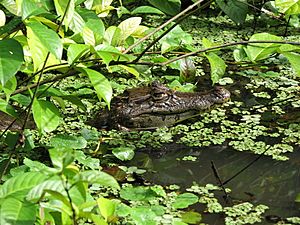
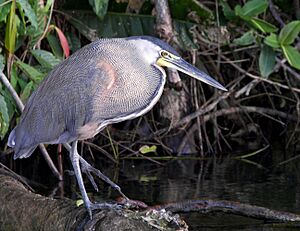
Tortuguero National Park is a safe home for many different animals. You can find birds, mammals, marine life, and, of course, sea turtles here. Many of these animals are also found in other protected areas nearby.
Some of the animals that are in danger and live in the park include the American crocodile, Baird's tapir, and different types of marine turtles. The manatee (also called a sea cow) also lives here. The park is a very important place for many fish species that local people rely on for food.
Sea Turtles and Water Animals
The long beach, stretching for almost 22 miles, is a famous nesting spot for sea turtles. These "beach-nesting turtles" come to lay their eggs during the winter months, from February to July. The main types of turtles you might see are hawksbills, loggerheads, green turtles, and leatherbacks.
The rivers in the park are home to manatees, as well as caimans and crocodiles. You can also find a unique fish called the tropical gar, which is like a "living fossil" because it has been around for so long.
Mammals and Birds
The forests of Tortuguero are home to at least four types of wild cats found in Costa Rica: jaguars, ocelots, jaguarundis, and pumas. You can also spot three of Costa Rica's four types of monkeys: Geoffroy's spider monkey, the mantled howler, and the white-headed capuchin. Other mammals include three-toed sloths, paca, peccary, tapir, white-tailed deer, and armadillo.
The park is a birdwatcher's paradise, with 442 different species! You might see kingfishers, toucans, great blue herons, and parrots. Many birds that travel long distances (called neotropical migratory birds) fly through this park. One special bird is the crested eagle, which is the second-largest bird of prey. The great green macaw is another beautiful bird here that is endangered. Almost one million birds stop in this park during their migrations each year.
Fish, Reptiles, and Amphibians
The park's waters are full of life, with many freshwater and marine fish species. Some common fish families include Cichlidae and Characidae. You can find species like the bobo mullet, bull shark, tarpon, and snook.
There are also 54 species of amphibians and 110 species of reptiles known in the park. This includes different types of land turtles, Caiman crocodilus, Crocodylus acutus, basilisk lizards, and colorful poison-dart frogs.
Amazing Plants of Tortuguero
As of 2006, there were 779 known plant species in the park. About 36 of these are found only in Costa Rica! Other reports say the park has more than 400 types of trees and about 2,200 other plant species.
Along the Caribbean coast, you'll find mangrove forests. The forests in this area have tall trees like the gavilán, caobilla, almendro, and the monkey pot tree. The last two are almost endangered. While most of Costa Rica's mangrove forests are on the Pacific Coast, a small but important part is found here.
In the lakes, marshes, and floodplains, you can see palms like Raphia taedigera and Manicaria saccifera. Floating plants like Azolla and Eichhornia can cover the streams during the dry season. There are also many other trees with thick undergrowth and several types of small palms.
Visiting Tortuguero National Park
Tortuguero National Park is surrounded by private land used for cattle farming and agriculture. The park itself doesn't have people living in it permanently anymore. Long ago, people used to log timber, hunt turtles, and collect animal skins here.
Today, fishing and tourism are the main activities for local people. Visitors are guided to explore the creeks, lakes, and nature trails. You can watch wildlife and even see turtles laying their eggs! The park also holds workshops to teach people about protecting nature.
You can enter the park from the Cuatro Esquinas center in the village of Tortuguero. From there, you can find several trails. There are three water trails, with the Harold trail being the most popular. There's also one hiking trail called the Gavilan Trail, which is about 1,920 meters long. Other trails lead up to Tortuguero hill, where you can find a tower with amazing views of the area.
Protecting Tortuguero's Nature
Illegal cutting of trees inside the park has made it easier for poachers to reach the green sea turtle nesting beach. This beach is the second-largest in the world for green sea turtles! Other threats include cutting down certain palm trees for roofing, changes in river paths, and dirt washing into the rivers from banana farms. Illegal hunting is also a serious problem, affecting animals like paca, peccary, tapir, white-tailed deer, armadillo, and sea turtles and their eggs.
To help protect the park, there are conservation projects. These projects aim to organize land use, protect water resources, and support local communities. The National System of Conservation Areas (SINAC) is in charge of managing these efforts. In the early 1990s, projects were started with help from the Ministry for the Environment and Energy (MINAE) and the European Union (EU). These projects focused on planning how land is used, protecting water, strengthening local groups, and supporting research.
Images for kids
-
Spectacled Caiman in the Tortuguero National Park.
See also
 In Spanish: Parque nacional Tortuguero para niños
In Spanish: Parque nacional Tortuguero para niños


